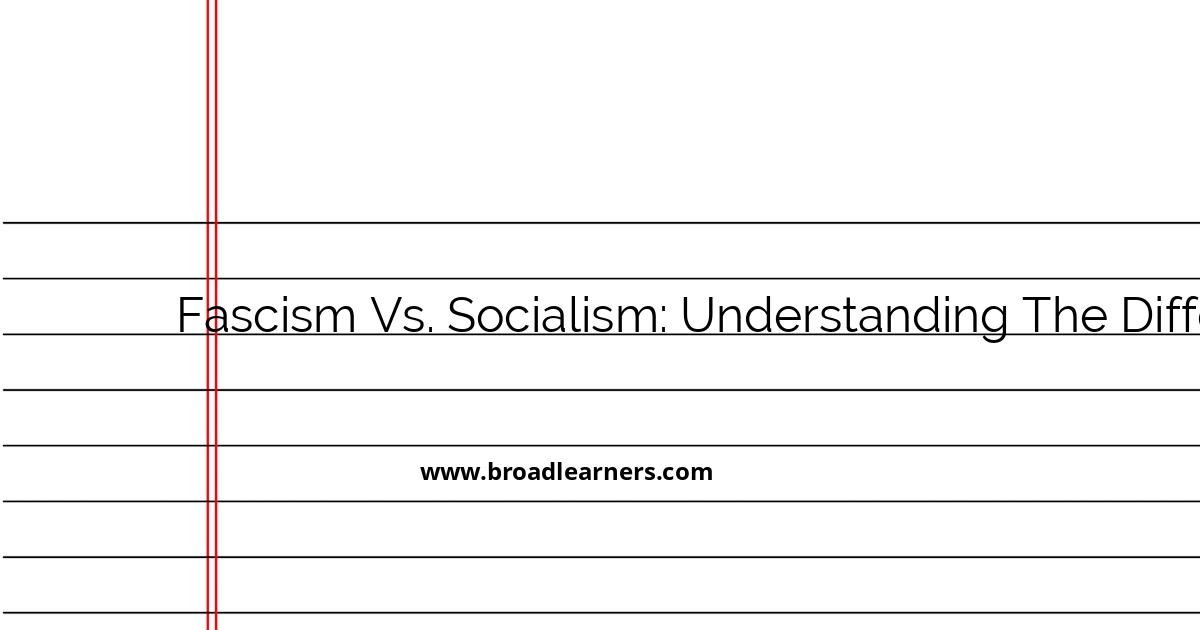The terms fascism and socialism often appear in political discourse, yet they represent vastly different ideologies. Understanding these differences is crucial for anyone engaging in discussions regarding political systems and their implications for society. In this article, we will explore the fundamental differences between fascism and socialism, providing detailed explanations and examples.
1. Definition and Ideological Foundation
- Fascism
- Fascism is an authoritarian and nationalistic right-wing system of government characterized by dictatorial power, forcible suppression of opposition, and strong regimentation of society and the economy. It often emphasizes the supremacy of the state or leader and promotes militarism and nationalism.
- Socialism
- Socialism is a leftist political and economic ideology advocating for social ownership or control of the means of production and the redistribution of wealth to achieve social equity. The focus is on reducing inequality and providing social welfare to all citizens.
2. Key Characteristics and Principles
- Fascism:
- Centralized Power: Power is concentrated in the hands of a single leader or party, and democratic processes are often suppressed.
- Nationalism: Extreme pride in one's nation, often accompanied by xenophobia or a desire for territorial expansion.
- Militarism: A strong emphasis on military strength and the belief in the use of force to achieve national goals.
- Suppression of Opposition: Political dissent and opposition are forcibly suppressed, often through censorship and propaganda.
- Socialism:
- Social Ownership: The means of production are owned or regulated collectively by the society or the state, aiming to benefit the community as a whole.
- Economic Equality: Efforts are made to distribute resources more equally among all citizens, reducing the wealth gap.
- Welfare State: The provision of extensive social services such as healthcare, education, and social security for all citizens.
- Democratic Processes: Emphasis on democratic decision-making and public participation in economic and political matters.
3. Economic Systems
While fascism and socialism both involve state intervention in the economy, they differ in their approaches and objectives:
- Fascism: The economy is often controlled by a central authority, with private property and enterprise allowed but under strict government regulation. The state directs production to serve national interests, prioritizing military and industrial outputs.
- Socialism: Economic planning is used to allocate resources and ensure fair distribution. The focus is on public welfare, with industries and services owned or managed by the community or state to benefit all, not just the wealthy.
4. Social Implications
Fascism and socialism have profound impacts on society, influencing cultural, social, and individual lives:
- Fascism: Promotes homogeneity and conformity, often at the expense of individual freedoms and cultural diversity. Social hierarchies may be enforced, and minority groups may face discrimination.
- Socialism: Encourages social justice and equal opportunities, aiming to uplift disadvantaged groups and reduce social inequalities. Diversity and cultural expressions are generally valued and protected.
5. Examples in History
Historical examples stand as testimonies to the practical application of fascism and socialism:
- Fascism:
- Nazi Germany: Under Adolf Hitler, Germany practiced extreme nationalist policies, racial purity, and aggressive expansionism, leading to WWII and the Holocaust.
- Fascist Italy: Led by Benito Mussolini, Italy emphasized national greatness and pursued imperial ambitions.
- Socialism:
- The Soviet Union: Under leaders like Vladimir Lenin and Joseph Stalin, the USSR implemented socialist policies of centralized planning and collective ownership, albeit with authoritarian elements.
- Modern Scandinavia: Countries like Sweden and Denmark adopt socialist principles of a welfare state within a democratic framework, ensuring high levels of social services and equality.
In conclusion, while both fascism and socialism propose forms of government and economic organization, they represent opposite ends of the political spectrum in terms of ideology, practice, and social impact. Understanding these differences is essential for thoughtful and informed political discourse.

Did I miss anything? Respond below